Constantinople, Church of Divine Wisdom
Q12506Constantinople (Κωνσταντινούπολις) or Byzantium (Βυζάντιον): Greek city on the Bosphorus, capital of the Byzantine Empire, modern İstanbul.
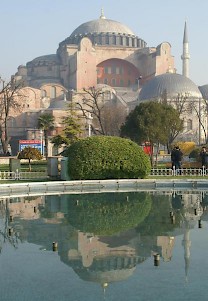
The main church of Constantinople was the famous Hagia Sophia, the Church of the Divine Wisdom. It was built near an older Christian sanctuary, the Church of Divine Peace or S. Irene. The two shrines were also called "the old church" and "the new church", for example in the Notitia Urbis Constaninopolianae.
Constantine's church
The Hagia Sophia was built for the first time by the emperor Constantine the Great (306-337), but was not finished until the end of the reign of his son Constantius II: in 360, to be precise. Although the church was used by the patriarch, it was probably not yet the city's main church; when the emperor Theodosius invited the bishops to discuss the Nicene Creed (in 381), this First Council of Constantinople took place in the Church of Divine Peace, and not in the Hagia Sophia.
It was in the church of Constantine, situated directly to the north of the imperial palace, that patriarch John Chrysostom in 399 offered asylum to Eutropius, the right-hand man of the emperor Arcadius (r.395-408), when the powerful consul was attacked by the empress Eudoxia I. Although Eutropius was dead before the end of the year, Eudoxia now hated John, and did not test until she had him exiled. In 403, she was successful, when the Synod of the Oak condemned the patriarch for his support of several Origenist monks. When he was exiled to Bithynia, there was a riot, there were riots, and John was recalled.
Six months later, a silver statue of the empress was erected at Augusteôn Square near the Hagia Sophia. The patriarch protested against this pagan excess and Eudocia's vanity, and on 20 June 404 he was - rather predictably - sent into exile again, this time to Armenia. During the night of his departure, the first Hagia Sophia burned down. In October, Eudoxia died of a miscarriage, soon followed by John. The rebuilding of the church was left to Arcadius' son Theodosius II (r.408-450) and his sister, Pulcheria.
Theodosius' church
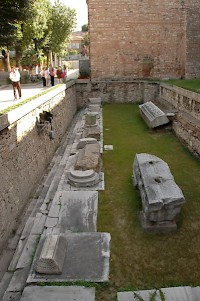
This "Theodosian Church" was inaugurated on 10 October 415. Near the current entrance of the Hagia Sophia, some remains of this monument are still visible in the garden, and archaeologists believe that the cathedral of Theodosius II had more or less the same map as the third phase - which became necessary when the Theodosian Church was burned down during the Nika Riots (13 January 532).
Justinian's first church
The first stone of the third Hagia Sophia was laid on 23 February, just forty-one days after the Theodosian Church had been pillaged and destroyed.
The architects of the new church, which is connected with the name of the emperor Justinian (r.527-565), were Anthemius of Tralles and Isidore of Miletus. The first of these had already designed the charming SS. Sergius and Bacchus, and more or less reused the map of that church, although on a much larger scale, and with a different type of dome. The church was dedicated after less than six years, on 26 December 537. When Justinian entered the new Church of the Divine Wisdom, he modestly noted that he had surpassed King Solomon. This church is described in great detail by Procopius, at the beginning of his book on the Buildings of Justinian.
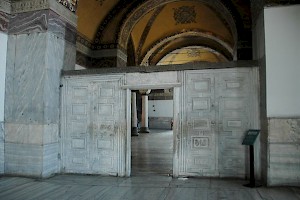
An interesting detail from this age is the Wall of the Council, which can be found on the first floor of the southwestern nave. In 553, the bishops of the Fifth Ecumenical Council behind this wall to discuss the Three Chapters, which had once been designed to win back the Monophysites for the church, but had only served to estrange the church of Constantinople from the church of Rome. The chapters were now condemned.
Justinian's second church
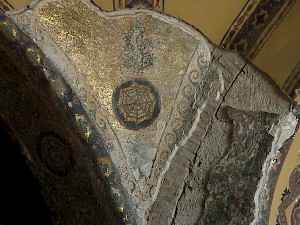
In that same year, the Hagia Sophia suffered from an earthquake, and this happened again in 557. As a result of these shocks, the dome became unstable, and it collapsed on 7 May 558. A new architect was found, a nephew of Isidore of Miletus who was also named Isidore. He found the solution, making the new dome a bit higher. The forces would now be more vertically directed, which indeed resulted in a more stable construction. He also added two couples of buttresses on the southwestern and northeastern side. The cathedral was rededicated in 563.
From an architectural point of view, the church of SS. Sergius and Bacchus are the Hagia Sophia are interesting, because the architects were still trying to find out how they could place a dome on high piers - an altogether more daring concept than the Pantheon in Rome, where the dome rests on a large wall.
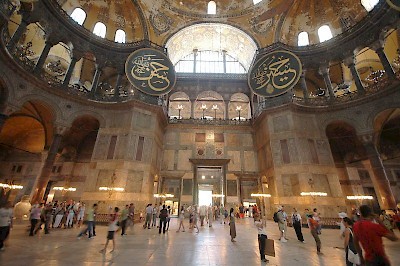
The cathedral, which is about 75 m long and 70 m wide, is laid out so that its southeastern apse faces to the place where the sun rises at the time of the winter solstice - a reminder of the belief that Christ is the light of the world. It has three naves, which are separated by the piers on which the dome rests. The naves in the northeast and the southwest have two floors; Mass could be attended from the galleries as well. The central nave is lengthened in the southeast and in the southwest with three apses. In the two times two side-apses, two columns support the arch; they were recycled from the Temple of the Sun in Rome ("spolia").
The Church of the Divine Wisdom is famous for its marble columns - with splendid capitals - and its mosaics. Most of these are Medieval, but on some places, the original decoration can still be seen. Black and gold are the dominant colors, and it is easy to imagine what Procopius writes:
The Hagia Sophia abounds exceedingly in sunlight and in the reflection of the sun's rays from the marble. Indeed one might say that its interior is not illuminated from without by the sun, but that the radiance comes into being within it, such an abundance of light bathes this shrine.note
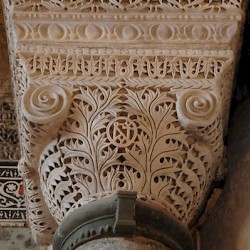 Constantinople, Hagia Sophia, Nave, Capital |
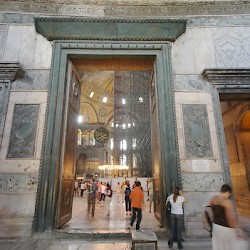 Constantinople, Hagia Sophia, Narthex, Imperial gate |
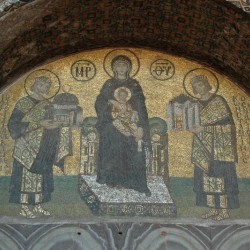 Constantinople, Hagia Sophia, Splendid Gate |
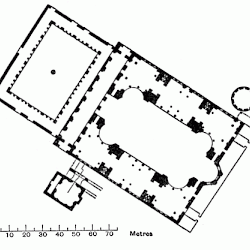 Constantinople, Hagia Sophia, Map |
Later history
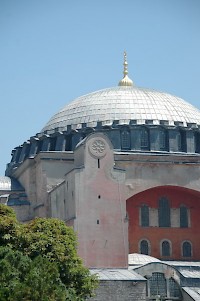
In 1204, the church was looted by the Crusaders. The Chronicle of Novgorod describes what was lost: a silver-cased pulpit was broken, the throne of the patriarch was used by a prostitute, and crosses, icons, silver lamps, and gospels were taken away. The operation was conducted by Dandolo, the doge of Venice, who died not much later and lies buried on the first floor of the southwestern nave. Constantinople now became the capital of a Latin Empire, which had to fight against two Greek Byzantine Empires. The Turks could improve their position, and although Constantinople became Greek again in 1261, it was a matter of time until the city was to be Turkish.
Ottoman architects benefited from the experiences of Anthemius and the two Isidores. If their mosques are more elegant, it is because they are lacking the enormous buttresses that the Byzantine architects still deemed necessary.